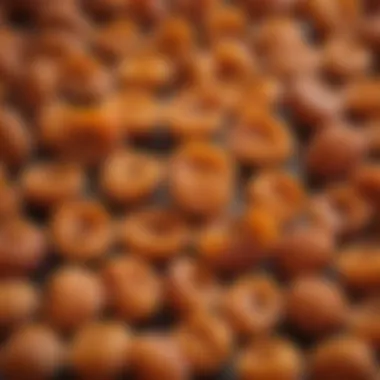Best Dried Fruit Options for Diabetics


Intro
Navigating the world of food can feel like walking a tightrope, especially when managing diabetes. Awareness of what to eat is paramount, particularly when considering the sweet temptations of dried fruit. Although these little bites can be tasty, they can also be tricky when it comes to blood sugar levels. This exploration digs into the best options for dried fruit that align with a diabetic's dietary needs, focusing not just on the nutritional values but on how these fruits can integrate into a well-rounded menu for optimal health.
As tempting as it may be to grab a bag of fruit without a second thought, it's essential to recognize that drying fruit often concentrates its natural sugars. Understanding the unique properties of various dried fruits and their glycemic indices can lead to informed choices that keep blood sugar in check while allowing for a diverse flavor experience. This article aims to help individuals with diabetes enjoy the benefits of dried fruits without compromising on their health goals.
Understanding Diabetes and Nutrition
Understanding how diabetes interacts with nutrition is a key aspect of managing the condition effectively. Diabetes is not just a single ailment; it has layers, types, and unique responses to food. Through the lens of nutrition, we uncover various avenues for support, improving blood sugar control and overall well-being. A wise dietary approach can often make or break daily experiences for those with diabetes.
Nutritional choices play an indispensable role in maintaining optimal blood sugar levels, crucial for avoiding the complications that can arise from this condition. Hence, this section is pivotal as it lays the groundwork for exploring how specific foods, like dried fruits, fit into a diabetic-friendly diet.
Defining Diabetes and Its Types
Diabetes essentially refers to a group of diseases that affect how your body uses blood sugar, or glucose. The main types include Type 1, Type 2, and Gestational diabetes.
- Type 1 Diabetes: This is an autoimmune condition where the body cannot produce insulin, an essential hormone for glucose metabolism. Individuals with type 1 require lifelong management with insulin replacement.
- Type 2 Diabetes: This form occurs when the body becomes resistant to insulin or fails to produce enough of it. It’s often associated with lifestyle factors, and many can manage or even reverse it through diet and exercise.
- Gestational Diabetes: This type occurs during pregnancy and typically resolves after giving birth. However, it does increase the risk of developing Type 2 diabetes later in life.
Recognizing these differences is important for individuals as it shapes their approach to food and nutrition, particularly for those seeking to manage their blood sugar effectively.
The Role of Diet in Managing Blood Sugar
Diet and diabetes management go hand in hand. For those coping with diabetes, it’s not merely about eating less sugar or counting carbs; it's about understanding how different foods affect insulin and blood sugar levels. The key aspect here is the balance. Meals consisting of fiber-rich ingredients, proteins, and healthy fats can modulate blood sugar responses.
A diet rich in vegetables, whole grains, and lean proteins can lead to a more stable blood sugar level. Even snacks shouldn't be neglected. Healthy nibbling options can keep cravings at bay and help manage weight, which is vital for those with Type 2 diabetes. Consequently, thoughtful dietary choices enable an individual to lead a fulfilling life without significantly compromising on taste and enjoyment.
Importance of Glycemic Index and Load
The terms Glycemic Index (GI) and Glycemic Load (GL) are cornerstones in meal planning for those diagnosed with diabetes. The Glycemic Index measures how much a carbohydrate-containing food raises blood sugar levels compared to pure glucose. Foods with a low GI are digested slowly, resulting in a gradual rise in blood sugar rather than a spike. This slows down the insulin response, which is beneficial for those looking to maintain stability in their levels.
Glycemic Load takes this a step further by considering the carbohydrate quantity in a serving of food alongside its GI rating. For instance, a food with a high GI might still be appropriate in small portions, while a low GI option could be problematic if consumed in large amounts.
"Understanding and utilizing GI and GL can help individuals make informed choices about their meals, ultimately leading to better blood sugar control."
By familiarizing oneself with these concepts, those with diabetes can better strategize their dietary habits, ensuring that they consume foods that support rather than hinder their health goals.
Nutritional Profile of Dried Fruits
Understanding the nutritional profile of dried fruits is crucial for anyone managing diabetes. While these sweet snacks can pack a serious nutritional punch, they can also contribute to blood sugar fluctuations if consumed without caution. Hence, we’ll delve into their specific components—vitamins, minerals, fiber, and sugar concentration—providing insights essential for making informed dietary choices.
Vitamins and Minerals in Dried Fruits
Dried fruits are often rich in vitamins and minerals that benefit overall health. For instance, dried apricots are a notable source of vitamin A, crucial for maintaining eye health. Likewise, raisins stand out due to their considerable iron content, which is beneficial in preventing anemia.
Moreover, dried figs are packed with calcium, supporting bone health, and potassium found in dried bananas helps in maintaining healthy blood pressure levels. Notably, these micronutrients serve various functions in the body, from bolstering the immune system to aiding in metabolic processes. The concentration of these nutrients in a compact form makes dried fruits an attractive snack option for those needing nutrient-dense foods without consuming large quantities.


"When incorporating dried fruit into your diet, consider the variety to ensure a broad intake of essential vitamins and minerals."
Fiber Content and Its Benefits
Fiber is a significant player in managing blood sugar levels effectively. One of the standout features of dried fruits is their fiber content. For instance, prunes are famous not just for their delicious sweetness, but they’re also high in soluble fiber which can aid digestive health.
This fiber slows glucose absorption, helping to stabilize blood sugar levels. On the other hand, dried berries—such as blueberries and cranberries—are not just lower in calories but also rich in fiber, which can contribute to a feeling of fullness. This satiety can deter overeating and make it easier to control portions, an essential consideration for diabetics. Adding fiber-rich dried fruits to a diet can be akin to installing speed bumps on the blood sugar highway—slowing things down and allowing for better management overall.
Sugar Concentration in Dried Fruits
When considering dried fruits, it’s essential to keep a keen eye on sugar concentration. While naturally occurring sugars exist in fruit, the drying process intensifies their sweetness. For example, a handful of dried dates can have more sugar than a fresh apple.
Consequently, maintaining portion control is vital. Many people don’t realize that a small amount goes a long way. It’s wise to opt for unsweetened varieties wherever possible and be mindful of how much you consume. Generally, moderation is the key in this department. Having dried fruits as part of a more extensive meal can help offset their sugary punch, blending them into a broader dietary pattern that encompasses protein and healthy fats, thus promoting a balanced intake.
Understanding these components—the presence of vitamins, fiber, and sugar concentration—helps pave the way for making sound decisions when it comes to dried fruits in a diabetic diet. Readers can relish the enjoyment of varied flavors while still taking care of their health.
Best Dried Fruits for People with Diabetes
When considering a balanced diet suitable for managing diabetes, understanding the types of dried fruits can significantly influence blood sugar levels. While fresh fruits are often the go-to, dried fruits offer a concentrated source of nutrients. They can pack a punch in terms of vitamins, minerals, and fiber. However, they also come with some considerations. This section will delve into the best options available, ensuring that you can navigate through your choices wisely.
Dried Berries: Antioxidants and Fiber
Dried berries, including blueberries, cranberries, and raspberries, should be high on any diabetic’s list. They brim with antioxidants which help reduce oxidative stress in the body, a factor linked to various chronic diseases. The fiber content in dried berries is another boon—it's known to slow the absorption of sugar into the bloodstream, helping to maintain stable glucose levels. When munching on dried berries, just bear in mind to check the labels for added sugars, as some commercially available varieties might surprise you with a higher sweetened content.
Apricots: Low Glycemic Impact
Apricots are nearly the golden child in the world of dried fruits for those with blood sugar concerns. Their glycemic load is particularly low, leading to a gentle nudge in blood sugar levels rather than a rollercoaster ride. They are nutrient-dense and provide potassium, which is vital for heart health. This makes apricots a practical snack or addition to your meals. If you can find organic dried apricots, they usually come without sulfites, which some people may want to avoid for health reasons.
Dates: Moderation and Nutritional Benefits
Dates often come with a reputation for being sweet, and rightly so. They are a natural source of sugar, hence the need for moderation in consumption. However, they also deliver a wealth of nutrients including fiber, potassium, and magnesium. These nutrients can contribute to overall heart health and digestion. Eating one or two as a sweet treat can satisfy cravings without breaking the bank on your blood sugar control. It’s all about knowing your limits and integrating them smartly into your diet.
Prunes: Digestive Health and Sugar Control
Prunes are more than just an old-school remedy for constipation; they have their place in a diabetic’s diet, too. Rich in fiber, they aid in digestion and can help with blood sugar regulation. The sorbitol found in prunes can assist in slowing down the digestive process, which helps prevent spikes in blood sugar. Incorporating a handful of prunes into your daily routine can not only keep your bowel movements regular but may also help in managing your glucose levels effectively.
Figs: Nutrient Density and Portion Considerations
When it comes to dried figs, they are jam-packed with nutrients including calcium and iron. Their unique taste makes them a scrumptious option to include in your meals or snacks. However, be wary of portion sizes; figs can be high in sugar and calories. A little can go a long way. Enjoy them in moderation to reap their benefits without compromising your health goals. Figs can also be paired well with nuts or served atop yogurt for a balanced snack.
Always consult with a healthcare provider or nutritionist before making significant changes to your diet, especially when managing diabetes.
In summary, while dried fruits can be a delightful addition to any diet, it's crucial for those with diabetes to understand their unique properties. Dried berries, apricots, dates, prunes, and figs each bring various benefits, and with careful consumption, they can fit seamlessly into your diabetic-friendly eating plan.
Factors to Consider When Choosing Dried Fruits
Dried fruits can be a tasty addition to your meals and snacks. However, knowing what to look for is crucial, especially for those managing diabetes. Selecting the right dried fruits involves understanding their composition and how they fit into your overall diet. Let's delve into the important factors you should consider to make informed choices.


Added Sugars and Preservatives
One of the first things to check when selecting dried fruits is the label for added sugars. Many commercial dried fruits are processed with various sweeteners to enhance flavor. This can inflate their glycemic index—an important measure of how a food impacts blood sugar levels. For example, while raisins are naturally sweet, some varieties are sugared to be even sweeter. Always opt for dried fruits that have no added sugars or preservatives. Look for those labeled as "unsweetened"; they tend to be more diabetic-friendly.
"Checking nutrition labels is like reading the fine print of a contract; it can save you from getting into trouble later."
Another concern revolves around preservatives. Some dried fruits, such as apricots, may need sulfites to maintain color and freshness. These chemicals might not be suitable for everyone. Understand your body and how it reacts to these additives. The more natural the fruit, the better it is likely to be for your health.
Organic vs. Conventional Options
Next up is the choice between organic and conventional dried fruits. The organic label often signifies fewer pesticides and a better farming approach. While it may not directly impact blood sugar, opting for organic could reduce your exposure to potentially harmful chemicals.
In contrast, conventional fruits may hold up just as well nutritionally, but there’s the risk of residues from pesticides. Ultimately, if you lean towards organic, you're supporting better farming practices which can be a win-win.
Benefits of Choosing Organic:
- Less Chemical Exposure: Reduced risk of pesticide ingestion.
- Environmental Impact: Supports sustainable farming methods.
- Flavor: Some claim organic fruits taste better due to fresher processing conditions.
As with most decisions in diet, weigh the pros and cons in accordance with your budget and personal values.
Serving Sizes and Portion Control
Another cardinal point to consider is serving sizes. Dried fruit is concentrated in sugar and calories, so portion control is vital. A seemingly harmless handful can add up quickly. For instance, just 1 ounce of dried figs can have about 37 grams of sugar. It's easy to think you're not eating much, but the reality is the opposite.
To manage portions:
- Pre-Measure: Use small containers or bags for individual servings.
- Pair Wisely: Combine dried fruits with protein, like nuts or yogurt, to slow digestion and stabilize blood sugar levels.
- Mindful Eating: Engage with the food you eat—take note of flavors and textures. This process can help curb the tendency to overindulge.
Incorporating all these factors into your daily choices will help you enjoy dried fruit as a delicious and beneficial component of your diet, tailored to your individual needs.
Incorporating Dried Fruits into a Diabetic-Friendly Diet
Finding a balance in one's diet is crucial for managing diabetes effectively. Dried fruits can serve as a delightful addition to a diabetic-friendly meal plan, offering both taste and nutrition. When integrated thoughtfully, they can help in maintaining stable blood sugar levels while providing essential vitamins and minerals. The key is understanding how these fruits interact with one’s body and incorporating them wisely.
Dried fruits boast several benefits:
- Nutrient-Dense: Unlike fresh fruits, dried fruits like apricots and figs pack their nutrients into a smaller space, making them a concentrated source of vitamins.
- Portability: They are easy to carry, allowing for quick snacking without compromising health.
- Versatility: Dried fruits can be added to various dishes, enhancing flavors while offering health benefits.
However, caution is necessary. People with diabetes should remain vigilant about serving sizes and added sugars, which can spike blood sugar levels.
"A little goes a long way; moderation is key when it comes to dried fruits."
Snack Ideas with Dried Fruits
Snacking can be a slippery slope for those watching their blood sugar. However, dried fruits can elevate snacks without turning into sugar traps. Consider these rewarding combinations:


- Dried apricot slices with almond butter: The fiber in apricots slows down sugar absorption, and almond butter adds healthy fats.
- Trail mix with walnuts, raisins, and seeds: Combining dried fruits with nuts and seeds creates a satisfying mix that balances fats and carbs.
- Greek yogurt topped with dried cherries or cranberries: This pairing brings a delightful tartness with protein-rich yogurt, enhancing digestibility without overwhelming sugar levels.
Mixing Dried Fruits with Nuts and Seeds
The marriage between dried fruits, nuts, and seeds is nothing short of culinary heaven. This trio offers a great resource of protein, healthy fats, and fiber, providing sustainable energy. Here’s how to include them in your diet:
- Oatmeal topper: Sprinkling chopped dried figs and toasted almonds into your morning oatmeal can transform it into a powerhouse breakfast.
- Energy bites: Create no-bake energy bites by mixing rolled oats, chopped dried apricots, and sunflower seeds. These make excellent on-the-go snacks for busy days.
- Salad enhancer: A handful of dried cranberries and walnuts can add texture and sweetness to leafy greens, making salads more appealing to the palate.
Using Dried Fruits in Cooking and Baking
Dried fruits offer depth and character to dishes, going beyond their role as snacks. They can seamlessly integrate into various recipes:
- Savory dishes: Incorporate chopped dried apricots into grain salads or tagines for a sweet contrast against savory flavors.
- Baking: Replace sugar in baked goods with finely chopped dates; they provide natural sweetness while adding moisture.
- Sauces: Blend dried prunes into BBQ sauce to create a delicious glaze for meats, balancing sweetness with tang.
Incorporating dried fruits into one's diet isn’t just about enjoying a treat; it’s about recognizing their role as a facilitator of health, even for those managing diabetes. The versatility, taste, and nutritional benefits of dried fruits can enhance meals, making the diabetic journey less restrictive and more enjoyable.
Risks and Considerations
When it comes to incorporating dried fruits into a diabetic diet, there are several risks and considerations that one should keep in mind. Understanding these factors is crucial for making informed dietary choices while still enjoying the natural sweetness and flavor that dried fruits bring to the table.
Blood Sugar Monitoring
Monitoring blood sugar levels is paramount for individuals managing diabetes. Dried fruits, while nutritious, contain concentrated sugars. Therefore, it’s vital to stay aware of how they impact blood glucose. Here are a few tips to keep in mind:
- Track Your Intake: Regularly check your levels to see how particular dried fruits affect your blood sugar. This can vary greatly depending on the type of fruit, portion size, and even the time of day.
- Mind Portion Size: Eating a handful of dried fruits can seem harmless, but it can lead to unexpectedly high sugar levels. Aim for moderate portions; even a small serving can go a long way in maintaining stability in blood sugar.
- Combine with Protein or Healthy Fats: Pairing dried fruits with nuts or seeds may help slow sugar absorption. For example, adding almonds to your dried apricots can help manage blood sugar spikes.
"A little goes a long way when it comes to dried fruits, especially for anyone watching their blood sugar."
Potential Allergens in Dried Fruits
Another key consideration is the potential allergens that may lurk in your favorite dried fruits. While most dried fruits are safe, certain ones may pose risks, especially for those with specific sensitivities or allergies. Here are points to ponder:
- Sulfur Dioxide: Some manufacturers use sulfur dioxide as a preservative in dried fruits. This can cause reactions in those with asthma or sulfite sensitivity. It’s wise to check labels and opt for organic or minimally processed varieties if you have concerns.
- Cross-Contamination: If you have nut allergies, be cautious with mixed dried fruit and nut packages, as cross-contact might occur during production.
- Quality Over Quantity: Always choose high-quality, organic dried fruit when possible. These are less likely to contain harmful additives.
Keep these risks in mind when incorporating dried fruits into your meals and snacks. Doing so can help you enjoy their benefits without compromising your health.
Culmination
In wrapping up this journey through the realm of dried fruits and diabetes, it's clear that these snackable delights can play a crucial role in a diabetic-friendly diet. Understanding the nutritional profiles of various dried fruits not only helps in making informed choices but also highlights the balance of enjoyment and health. Dried fruits can be nutrient-dense, brimming with vitamins and fiber, yet their sugar content demands careful attention, particularly for those managing blood sugar levels.
Summary of Key Points
As we reflect on the intricate relationship between dried fruits and diabetes, a few core points stand out:
- Nutrient-Rich: Dried fruits like apricots and berries are packed with essential vitamins, minerals, and antioxidants, serving as a healthier alternative to sugary snacks.
- Glycemic Index: Different dried fruits have varied glycemic indices, which influence how they affect blood sugar levels. Choosing lower-GI options can be beneficial.
- Portion Control: Moderation is key. Even the healthiest snacks can pose challenges if consumed in excess. Understanding serving sizes helps maintain stability in blood sugar.
- Incorporation into Diet: Dried fruits can enhance meals and snacks, adding natural sweetness and texture while contributing to overall dietary diversity.
"The right choice of dried fruit can help balance taste and nutrition for those managing diabetes."
Final Thoughts on Dried Fruits and Diabetes
Dried fruits certainly deserve a spot on the plate of anyone keen on both flavor and health. While they are not a one-size-fits-all solution, selecting the right types and consuming them mindfully can bring a wealth of benefits. It's paramount to familiarize oneself with how different fruits behave in the body, considering individual responses to sugars.
As you embark on your dietary ventures, keeping in mind these insights will allow for a more fulfilling and health-conscious eating experience. In the end, it’s about striking a balance—enjoying the sweet things in life while keeping health front and center. If moderation is exercised and choices are made wisely, dried fruits can indeed be a delightful companion in the journey of health and flavor.







